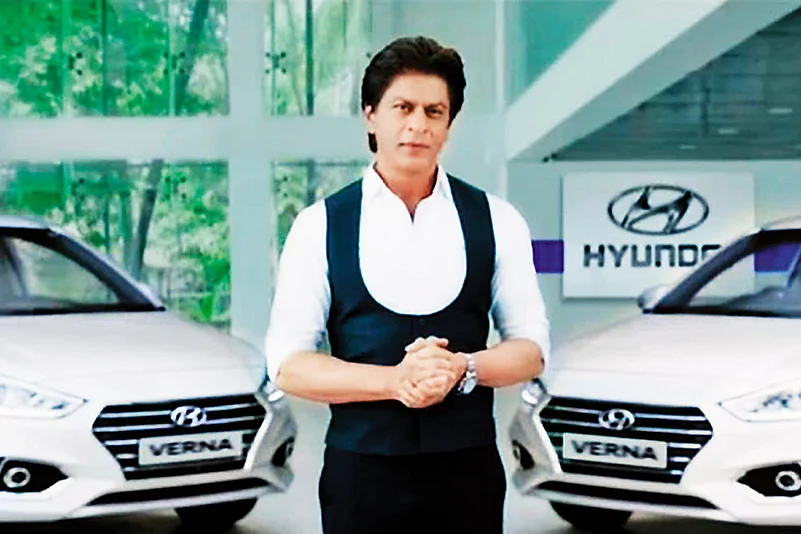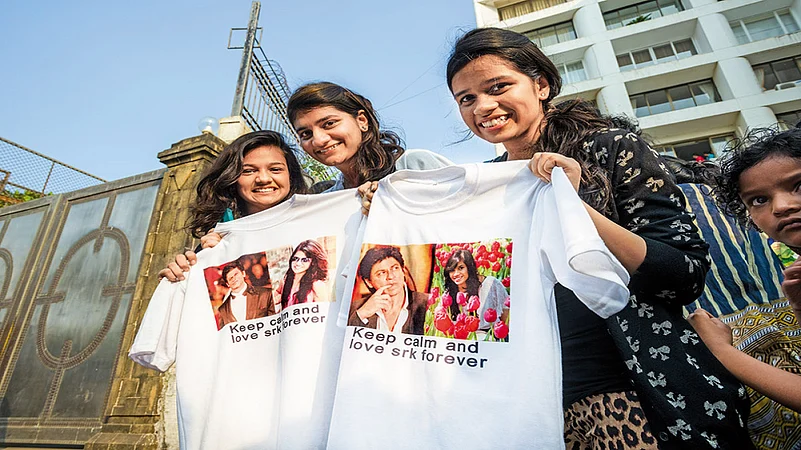Brand SRK is a much bandied about term. But what are its coordinates? More importantly, how does it connect with the 24x7 news cycle, obsessed with Shah Rukh Khan’s son Aryan’s arrest following a dubious drug-bust?
It is important to first map the brand’s textual trajectory through Khan’s cinematic oeuvre. SRK as a brand emerges in the late 1990s, fuelled by the overwhelming success of Aditya Chopra’s Dilwale Dulhania Le Jayenge (1995) and Karan Johar’s Kuch Kuch Hota Hai (1998). Characters essayed by SRK—lover boy Raj Malhotra and yuppie Rahul Khanna—rewrite the psychotic anti-hero image that come in films that preceeded them: Baazigar (1993), Darr (1993) and Anjaam (1994). The sheen of the later, romantic-domestic dramas, speaking to a rapidly liberalising economy and the attendant rise of the Hindutva movement, stamps out the grim residue of the angry young man, traces of which appear via mobilisation of the revenge genre—in SRK’s earlier works. Johar’s following productions—Kabhi Khushi Kabhie Gham (2001), Kal Ho Naa Ho (2003) and Kabhi Alvida Naa Kehna (2006)—build upon the enduring Raj-Rahul fiction, but begin to transmute the college-going lover-boy into a more complex adult, who may be biologically impure, diseased and dying, or sexually/morally transgressive. This mutation is also significantly marked by unmooring the “Indian” hero from the coordinates of the national territory (initiated by DDLJ), who will hereon be located in the global metropolises of London and New York, mediating the challenges of transnationalism. This body of films begin to acquire new audiences in affluent and cosmopolitan South Asian diasporic sites, and in previously unbroken Western territories like Germany, Austria and Switzerland. Retrospectively, as brand SRK ascends to global heights, “Bombay cinema” gets inaugurated as “Bollywood” on the global stage. Brand SRK then comes to function as the shorthand for popular Indian cinema in its shinier, Bollywoodised avatar.

Bombay cinema has always escaped easy ideological readings. In keeping with this vagrancy, SRK’s stardom, too, evinces disruptive strands that destabilise monolithic notions emerging from his popular canon. Dil Se (1998) marks romantic “national” imaginings as misplaced and doomed; Swades (2004) showcases reverse migration; Chak De! India (2006) questions the homogenising majoritarian fundamentalist discourses; My Name is Khan (2010) speaks to global Islamophobia in the post-9/11 world; and Raees (2017) dares to foreground minority subjectivities. In terms of their box-office clout and circulatory currency, these films do not match the cultural resonance of the former set. However, Hindi cinema’s endurance does not lie merely in distribution of its filmic texts, but more emphatically in their fragmentary disseminations. Sound-images of Chaiyya Chaiyya persist, escaping its textual borders, to circulate endlessly through global cultural texts serving as a recognisable hieroglyph of Bollywood. This August, when the Indian women’s hockey team reached the semi-finals in Tokyo Olympics, the team’s “real coach” Sjoerd Marijne was urged by the team’s “ex-coach”—the fictional Kabir Khan—to bring home the gold. The banter between the real and the fictional had twitterati in chuckles.
As Brand SRK begins to consolidate, specific films cast him in stories where the star plays upon his own persona, explicitly and reflexively: his own production house Red Chillies Entertainment’s Om Shanti Om (2007) and Billu (2009); and Yash Raj Films’ Fan (2016). Another strand in this braiding will construct an affinity with Tamil cinema’s traditions of star/fan-dom, evoking the regional megastar Rajinikanth: Billu, Ra.One (2011) and Chennai Express (2013). Brand SRK, then, dislodges the long-standing opposition between tradition and modernity, serving as an intermedia, mediating Bollywood as something that can at once be national, global and regional. If the textual terrain of Brand SRK is consistently transmutating, speaking differently to its divergent fans—straight/queer; men/women/transgender; wealthy/middle-class/poor; rural/urban/cosmopolitan; regional/national/transnational/global—then the extra-textual terrain reveals the instability even further.

The media’s interpretation of Brand SRK is predominantly mapped in terms of his commercial endorsements. From the outset, Khan has positioned himself as an indiscriminate celebrity-endorser, always available for hire. Industry insiders analyse this as a strategy that enabled him to sign films at half-the-price then commanded by his star-peers, instead earning his staple from commercials. Beginning small with Liberty Shoes (1988) and Brahmaputra Tea (1993), SRK quickly went on to associate with multinational corporations: Pepsi (1996), Hyundai (1998) and Tag Heuer (2003). His endorsement ensured an exponential 60 per cent annual growth for the luxury watch brand within two years. The leading advertising monitoring firm The Agency Source (TAS) indexed that between 1994 and 2006, SRK appeared in 281 print and 172 TV ads. Brand SRK then inaugurated a new revenue model for film stars, where endorsements became the primary revenue source instead of films. Overall, the celebrity-star has endorsed some 40 brands that currently include Dubai tourism, Frooti, Dish TV, Pan Vilas and even Fair and Handsome. Notably, Lux (2005) introduced SRK as its first male model in India, while Reebok (2010) launched a collection of footwear and apparel around the release of My Name is Khan.
According to the Duff & Phelps “Celebrity Brand Valuation Study”, SRK’s brand value stood at $66.1 million in 2019 and $51.1 million in 2020, accounting for the pandemic. Media reports indicate Khan’s current cost for the shoot of a TV ad at Rs 3.5-4 crore per day, and his visibility across all TV channels is estimated at an average of 4 hours per day. SRK’s eminently marketable, energetic presence has ensured the star’s omnipresence, through constantly running commercials, by framing him as conduit for a burgeoning consumerist society. Beyond cinema and advertising, his stage performances at public/private gatherings, and the numerous hosting gigs at award shows in national and transnational sites, adds to the density of brand SRK’s mediated assemblage. He is also prominently visible as the co-owner of three T20 cricket teams, most significantly Kolkata Knight Riders, who he cheers publicly. All this is augmented by his round-the-clock visibility on internet and social media: followed by 42 million on Facebook, 42.1 million on Twitter and 26.7 million on Instagram.

The sustainability of the polymorphous Brand SRK recently came to be questioned, following NCB’s arrest of Aryan Khan. On its heels, the edu-tech firm Byju (with SRK as its brand ambassador since 2017) faced calls of “Boycott Byju’s” trending on Twitter, and decided to temporarily take ads featuring SRK off-air. The ads resumed after a 4-5 day hiatus, leaving marketing gurus wondering if the resumption was incited by the social media backlash from Khan’s fans or the prevailing T20 World Cup, where Byju is a major sponsor. Khan’s private life has always vitalised his public aura: the early death of his parents; his interreligious marriage with a Punjabi Hindu Gauri Khan; and his role as a father to his children: Aryan, Suhana and AbRam. Even if Aryan’s arrest and remand remain highly questionable, the media circus attempts to threaten the image of a responsible father. Brand SRK has then revealed its instability and mutability sensitive to changes in context: social, cultural, industrial and ultimately, political. Is Aryan Khan’s arrest an omen for New India, in which a Muslim superstar cannot continue to serve as the metaphor for a Hindu-majority nation?
(This appeared in the print edition as "The Face of Another")
(Views expressed are personal)
ALSO READ
Priyadarshini Shanker, the writer, is assistant professor of Film Studies, University of North Carolina at Wilmington
















